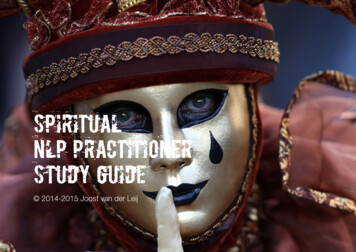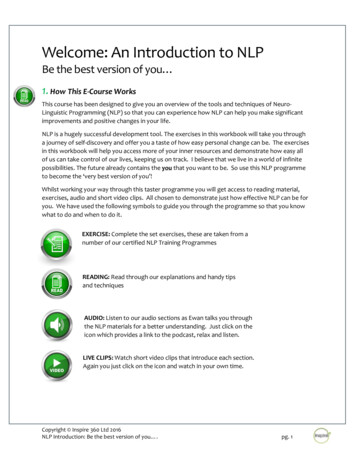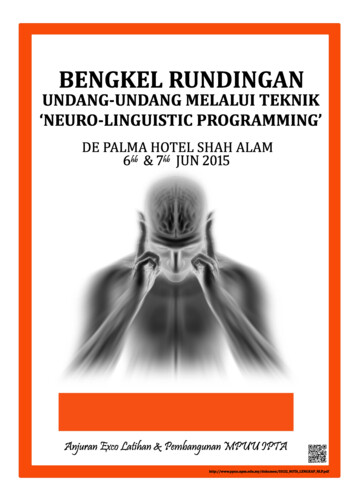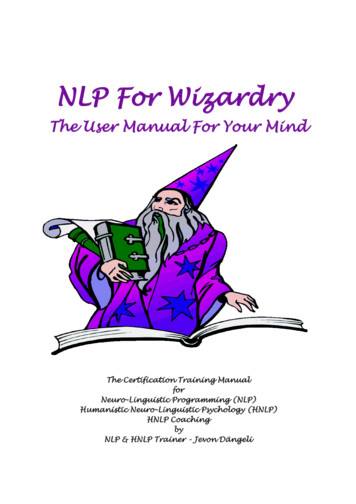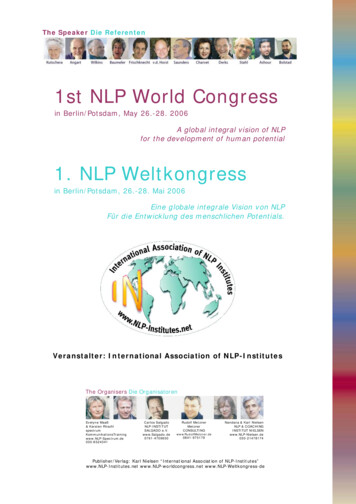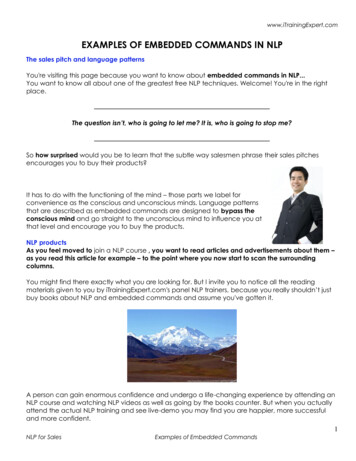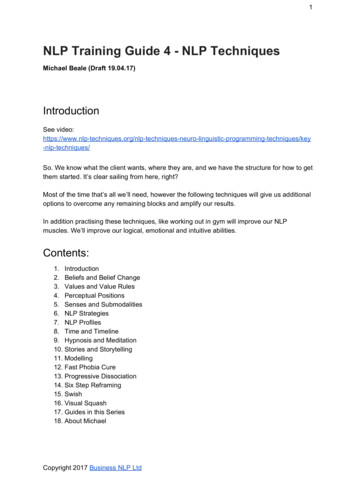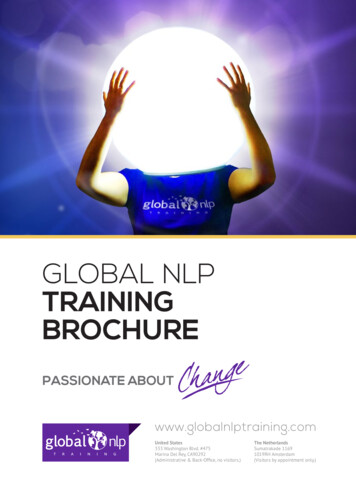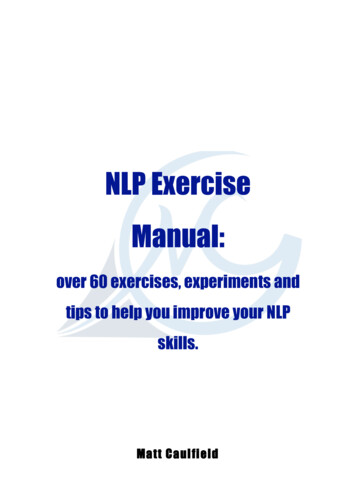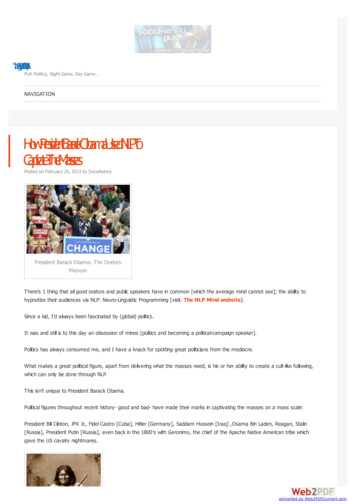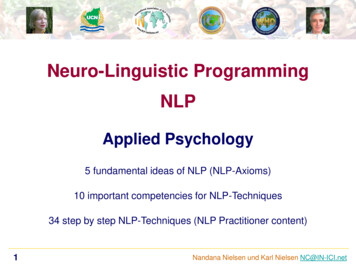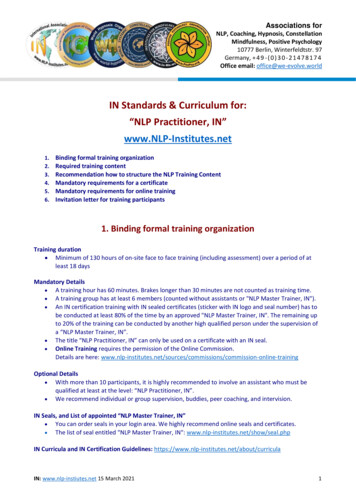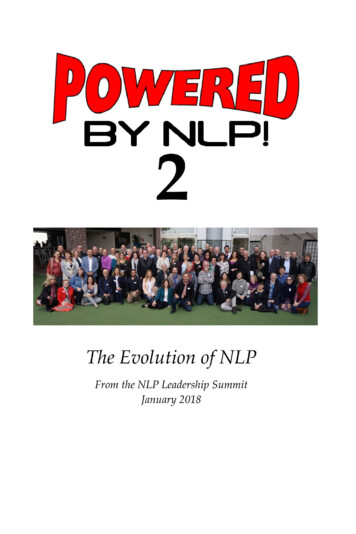
Transcription
The Evolution of NLPFrom the NLP Leadership SummitJanuary 2018
Published in Englandby GWiz Publishing(A division of The GWiz Learning Partnership)Oakhurst, Mardens Hill, Crowborough, E. Sussex. TN6 1XLTel ( 44) 1892 309205info@gwiznlp.comwww.gwiznlp.comIn the United States:NSP: Neuro-Semantic PublicationsP.O. Box 8Clifton CO. 81520 USATel (970) 523-7877meta@acsol.netL. Michael Hall, Ph.D.First published 2018.10 9 8 7 6 5 4 3 2 1 GWizNLP 2018All rights reserved.No part of this publication may be reproduced, stored ortransmitted in any way, without prior permission of the author andpublisher.ISBN: 978-0-9955979-1-4
ContentsviiForeword123The Summit1Understanding what happened at the summitAlone No MoreCommunity, inclusivity and ecologyPowered by NLP: ReflectionsThe wisdom of the fathers and mothers of NLP and theinternational code of ethics of NLP39111517Group Discussions27The spirit of collaboration and the leadership summitImagine we have an NLP archiveNLP at parenting and educationNLP in educationNLP in businessTechnology, Standards and the best of all worldsIn Service to the CommunityBig Picture GroupNLP 4th GenerationDreams of a bright future for NLP29333745536167697377Raising the Standards: Researching & Assessing NLP81Using Expert Validation to Define the Boundaries of NLPThe Results of the Survey – Preliminary FindingsUse Feedback scientifically through questionnaires and polesEvaluating Students Learning and Skill in NLPNLP-Trainer in the SpotlightTechnology, Standards and the Best of all WorldsLooking forward to the next summit while looking back838999119135143149APPENDIX 1: Researching NLP and NLPt153About the Authors159iii
Powered by NLP2!iv
The NLP Leadership Summit?Back in 2012, a collection of NLP ‘elders’ were invited to gather inLondon at the NLP Conference. This was the first meeting of the ‘NLPLeadership Summit’.An elder, in this case, is defined as somebody who: Has 15 years minimum experience in the field of NLP,Is recognised as a Leader in NLP (either as a trainer and/orsomeone who is leading people to NLP rather than standingon the apex),Is willing to sign up to the declaration, purpose and values.Each year, more elders from around the world are invited and the listcurrently adds up to about 150 people (listed on the website).For more information, go to the websitewww.nlpleadershipsummit.orgv
Powered by NLP2!vi
ForewordJoe ChealWelcome.Welcome to ‘Powered by NLP 2’, the second volume of notes andoutput from the NLP Leadership Summit meeting in Alicante 2018.This second large ‘colloquium’ for the Leadership Summit (asidefrom the annual meetings at the International NLP Conference inLondon) took place in January 2018. (A ‘colloquium’ is an informalmeeting for an exchange of views, where all individuals come to theroom as equals.)This three-day event allowed 80 NLP ‘elders’ from around the worldto meet and take time to discuss and work through the things thatmattered to them (and to the NLP communities they come from).Folks in attendance were:Rita AleluiaLeo AngartTomas BaenaKash Bhagwat-BrownLaureli BlythMelody ChealJoe ChealAndy ColeyPortugalGermanyPortugalUKAustraliaUKUKUKvii
Powered by NLP2!Gilberto CuryFrank DanielsLisa de RijkLucas DerksRobert DiltsAnneke DurlingerBert FeustelJose FigueiraNick FragkiasAndrea FrausinPeter FreethUeli R. FrischknechtMarianne GagnonMarcel Genestar AntanezRonit GoldbergJonathan GoldsmithL. Michael HallKris HallbomTim HallbomChristian HanischJoanna HarperHeidi HeronJaap HollanderRachel HottHelmut JelemEnrique JuradoNada KaiserRob KampsCornelia LabandowskyJeremy LazarusSteven LeedsNick LeForceHenrie LidiardJudith LoweDianne LowtherTerrence KUKAustralia
John McLachlanJohn McWhirterKaren MeagerAnneke MeijerMaria MendesKaren MoxomDavid MurphyLisa NewmanKarl NielsenColette NormandeauKarin PaetzePhil ParkerR. Frank PucelikJuan Francisco RamarezGermaine RedigerShelle Rose CharvetGilles RoyJulian RussellOmar SalomPeter SchutzJoseph SolerSlavica SquireRobbie SteinhouseCatherine TamisierMohamed TarekJane TurnerBrian Van der HorstReb VealePhilippe VernoisVirginie VernoisSandra VicenteMilan VukasinovicRon WindauerLuzia WittmannWyatt WoodsmallCatalin ia
Powered by NLP2!Why This Book?Having edited Powered by NLP volume 1, it seemed natural topropose a ‘volume 2’ when attending the 2018 Leadership Summit.Because it was a tangible output from the first Summit in Alicante, Iwas given the opportunity to say a few words about the book.Fortune shone on me in the form of Kris Hallbom, who stood up andgave the book a spontaneous and glowing testimonial! There exists aphotograph with Kris and I standing side by side with her holdingthe book, looking amazing and me making a goofy face (which I amoften inclined to do when someone points a camera at me – seemsfunny at the time, but looks weird when captured as a frozen momentin time ‘nominalised’ as it were).For me, a book is a recording and a space for those who wish toreflect and speak about their reflections. It is also a space for folks togo away and do some research and then speak about their findings.The Group ExperienceThere were 80 people at the 2018 Leadership Summit in Alicante(including 15 ‘sponsors’ – newer leaders in the field). There is a totalof 150 people in the Summit as whole group, so nearly 50% made thejourney across the world to meet other like-minded NLP ‘elders’.I was personally struck by two things. Firstly, the large amount ofpeople with doctorates and master’s degrees – the education level inthe room was extraordinary. Of course, education is perhaps bluntwithout action and this brings me to my ‘secondly’: how a biggroup of people can come together and communicate with respect –even when it comes to the tougher conversations. And we were notjust a talking shop! We were moving beyond ‘associating’ into a callfor action.x
The Standard BearersThe Summit in 2016 was about building ‘Connection’. The 2018Summit was about Connection and Credibility. On a show of hands,everyone (as far as I remember) wanted a higher standard of qualityin NLP across the world. And so the potentially thorny issue of‘standards in NLP’ was raised and the discussion began.It got me thinking about the history of the word ‘standard’. Theetymology of the word appears to come from (a) Frankish, meaning‘to stand fast or firm (to stand-hard)’ and (b) Latin, from ‘extendere’,meaning ‘to stretch out’. From the mid-12th century, a standard hasbecome a flag a rallying point. From the late-14th century a standardhas also come to mean a weight, measure, or instrument by which theaccuracy of others is determined.And every standard must have ‘standard-bearers’, those who willstep up and take responsibility to ‘carry the flag’ and rally peopleto a cause. In the Leadership Summit of 2018, I saw a room ofstandard-bearers.About the BookIn this book, you will find opinions and views of individual writers,which are not necessarily true of the Leadership Summit as a whole.You will also find different styles of writing and from an editorialperspective I have made the choice to maintain the authors’ originalspelling and grammar wherever possible (including a mix of Englishand US English).I am a facilitative editor and value ‘minimum input for maximumquality return’ (a business version of my dad’s philosophy ‘anything for an easy life’!) This book was a bigger task than the firstbook, with many more contributors. However, I want to thank eachand everyone of the authors here-in for helping to make the job anutter pleasure. I have also taken a light touch in my editing of thearticles themselves. I have added a bit of ‘englishising’ and grammarxi
Powered by NLP2!where needed but have endeavoured to leave the author’s originalmaterial wherever possible.I have organised the book is into three key areas:1) The SummitThese articles are mainly personal reflections and biggerpicture overviews of their experience of the Summit.2) Group DiscussionsMost of these articles are based on the output andrecollections of facilitated discussions had throughout theSummit. Some of the articles may not be a direct output froma discussion group but are thoughts inspired by thosediscussions.3) Raising the Standards: Researching & Assessing NLPThis section, on the whole, is a more ‘academic’ set of articles,designed to engage us in a conversation about raising thestandards of NLP.xii
PART ONETHE SUMMIT1
Powered by NLP2!2
Understanding What HappenedAt the SummitL. Michael Hall, Ph.D.If you were not there at the NLP Leadership Summit, you might bewondering what happened? How could we spend three full days ifno one was speaking or leading a training? What did we do? Howwas it organized? As a “Summit” the experience was structured sothat we would have informal yet guided conversations about thingsmost important to us. This was the intention of the Summit:Our primary task and purpose is to create a context in which theNLP Leaders talk with and to each other. The purpose is to get toknow each other, have the conversations that we need tohave, and to associate.To that end, the design of the Summit was also for co-leadership. It isnot a Conference where there would be speakers and speeches norkeynote speakers. It was not a training for skill development andexercises. Instead, starting from the place of assuming that we arecolleagues, that is, that each person is a leader in his or her communityand working to bring people into the field of NLP, we would so honorand respect each other. We would share our visions for the field. Wewould share our strengths and best practices. And we should talkabout our challenges. That’s what a Summit is for.Now unlike an Association which would have various agendas tofulfill as an organization, we gathered at Alicante Spain to justassociate with each other. Using this design in the previous Summits(seven of them), we had seen this approach has so far eliminated“politics” and discussions about the distribution of “power” (who’sin charge, who gets to decide things, etc.). By design, the Summit is3
Powered by NLP2!a meeting of who we are (leaders) caring about what we care mostabout (the future of NLP).I had anticipated that we would all be tested by the Summit in that wewould be required to practice with ourselves what we all know aboutcommunication and relationship. More than likely every singleperson (or almost every single one) had facilitated groups toeffectively communicate and/or also taught the NLP CommunicationModel, the Meta-Model, etc. So in coming together in this way, theSummit would offer us an unique opportunity to practice what wepreached. The question then was, “How will we do?”Guiding QuestionsTo guide the conversation, we created a number of Guiding Questions.Heidi Heron and myself put these together and presented them to thegroup before we gathered at the Summit. That led a few others tooffer some additional questions. We used the guiding question as away to hold the conversations. Obviously trying to do that with 75people would be too much, so we kept dividing into smaller groups,usually 8 to 10 people around a table.At each table someone would volunteer, or be drafted (!), to be thefacilitator. Once a facilitator was chosen, that person would assignsomeone to be the Reporter who would report back to the plenarysession. The facilitator sometimes would appoint some other roleslike time-keeper, monitor, etc. The design of the process was not tocreate any final answers. Instead it was to express each person’sviews and to hear each other out. It was to understand each other’sthinking and understanding. We also added that in the case that wedo come to some unanimous decisions, that would be an extrabenefit, but not the purpose. In this way, we kept the purposesimpler and easier to accomplish.Starting from the assumption that, as NLP Leaders, we are allcommunication experts(!) then surely we should know how to4
communicate, how to listen, how to match, how to explore, and howto embrace differences. That was our hope. And I think all wouldagree that we did that. So just as we did in 2016, the design is that wewill gather and operate as co-leaders.The Structure of the SummitSeveral times a day (4 or 5 times) we separated into smaller groupsof 8 to 10 people to address one of the Guiding Questions. As eachgroup appointed a Facilitator and a Reporter—in that way everybodywho wanted to, got a chance to facilitate and to report back to thelarger group. In mixing up in that way, we all got a pretty goodchance to get acquainted with each other and we got to see andexperience each other’s skills and abilities as leaders.For the facilitation, we wrote the following. When you are thefacilitator, your job is to do the following:1) keep the group focused on the question,2) enable the group to have a dialogue with each other,3) help each person have his/her time to speak,4) help each person to be succinct and get to the point,5) keep the time of the group, cuing the Report when tosummarize,6) interrupt if need be to help a person say on track.When you are the Reporter, your job is to do the following:1) take notes of the conversation,2) summarize the notes with the group toward the end of thetime period, and3) report your insights, discoveries, conclusions, line ofreasoning to the larger group.The design of the first Guiding Question on Day One was to starteverything off on a positive note and thereby to establish a positivespace. After that, the questions focused on dealing with some of thechallenges
Why This Book? Having edited Powered by NLP volume 1, it seemed natural to propose a ‘volume 2’ when attending the 2018 Leadership Summit. Because it was a tangible output from the first Summit in Alicante, I was given the opportunity to say a few words about the book. Fortune shone on me in the form of Kris Hallbom, who stood up and gave the book a spontaneous and glowing testimonial .
